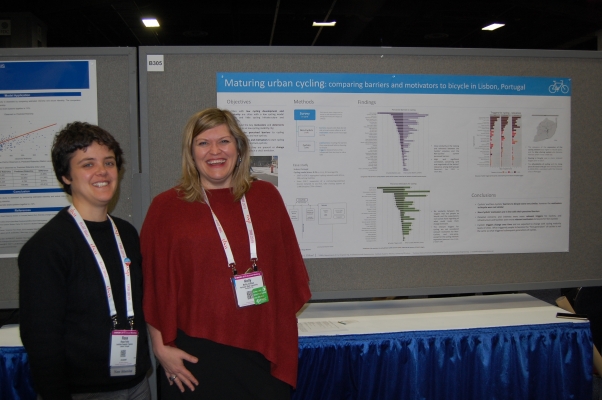Context-Specific Modeling Supports Strategic, Multimodal Investments

In recent decades, cities have become increasingly motivated to invest in infrastructure that supports multimodal options like walking, biking and public transit. Trip generation, the first step in conventional four-step forecasting models, is a central figure in determining how those investments are made.
However, when considering pedestrian and bicycling travel, the current practice is usually to either leave those trips out of the model altogether, or to simply present them as a mode choice option that is not analyzed further. In short, they’re car-centric.
Without reliable trip generation rates for anyone but drivers, an accurate transportation impact is difficult to predict. Certain land uses will draw far more walkers, cyclists and transit riders than drivers. Cities lack enough information to strategically plan for multimodal investments.
Researcher Kelly Clifton of Portland State University (PSU) has worked on an extended series of projects developing new tools to address this knowledge gap. PSU is home to the National Institute for Transportation and Communities (NITC)– a university transportation center that focuses on improving the mobility of people and goods to build strong communities.
Evolution of Trip Generation: a Holistic Approach
Particularly in dense urban areas with a greater mix of land uses, the trip generation rates used by the Institute of Transportation Engineers (ITE) tend to overestimate the number of vehicle trips while failing to adequately address non-automobile modes. In her 2011 study “Contextual Influences on Trip Generation” Clifton developed a model to adjust ITE’s trip generation rates for urban contexts using local data from Portland, Oregon. It has since made its way into the ITE Trip Generation Handbook.
As a follow up to her earlier studies, Clifton proposed a new unit of measure on a finer scale than the industry standard TAZ (Traffic Analysis Zone). Offering a higher level of spatial acuity and behavioral sensitivity, Clifton defines PAZ, or pedestrian analysis zone, in her 2013 study “Better Representation of the Pedestrian Environment in Travel Demand Models”. The key to this walk trip model is a new variable: the pedestrian index of the environment (PIE). The PIE, a weighted index of six different measures of the built environment, is calibrated to represent things that influence walking behavior: bicycle access, block size, people per acre, sidewalk density, transit access, and the area's compactness as measured by the Urban Living Infrastructure score (a metric developed for the Portland, Ore. region).
Applying a Framework
The next step was to take that micro-level pedestrian data and use it to predict destination choice in her 2016 study “Development of a Pedestrian Demand Estimation Tool”. For every walk trip generated by the model, this tool matches it to a likely destination based on traveler characteristics and environmental attributes. Developed in partnership with Oregon Metro, the goal of this research is to increase the representation of walking within travel demand models, and to design a replicable tool for other metropolitan areas that works within the existing four-step model:
Building upon this body of work, Clifton developed a multimodal framework for transportation impact analysis in her 2017 study “Improving Trip Generation Methods for Livable Communities”. She partnered with fellow NITC consortium researcher Nico Larco of the University of Oregon in pooling data from Oregon and California to create a combined sample of over 180 sites in a variety of urban contexts. The research further refines trip generation methods by expanding the number of land use types considered, adding mixed-use developments, and estimating the number of person trips, including those made by non-automobile modes.
The aim of the study was to determine the site-level and urban design characteristics that inform multimodal trip generation. Based upon qualitative assessment, combined with the quantitative information collected previously, the team was able to identify certain trends in the built environment, traffic operations, transportation movements and site visitors that are influential to trip generation.
The most important outcome of this research is a framework for sustainable multimodal planning, which includes an approach for site-level and area-wide analysis. The flexible, transparent approach to data collection and analysis is helping to create a system where land use planning and transportation impact analysis are inextricably linked -- thus giving agencies more autonomy to decide what the character of a place should be based on the needs of the people who live there. Travel choices are complex and there is increasing recognition that perceptions, attitudes, motivations, social norms and other psychosocial characteristics play an important role.
The Next Stage in Deconstructing Travel Behavior
On the horizon is a newly funded, multi-university NITC project: “Key Enhancements to the WFRC/MAG Four-Step Travel Demand Model” - led by Reid Ewing of University of Utah, Kelly Clifton, and Shima Hamidi of the University of Texas at Arlington. The research team seeks to develop and implement car shedding, intrazonal travel, walk and bike mode choice, and peak spreading models that can be used in conjunction with a conventional four-step model to capture neglected effects of the built environment on travel behavior.
Clifton's work over the past seven years has revolutionized travel demand forecasting, comprehensively incorporating multimodal options into each step of the modeling and planning processes. This work will help planners improve mobility for all users of the transportation system.
The National Institute for Transportation and Communities (NITC), is a program of the Transportation Research and Education Center (TREC) at Portland State University. NITC is one of five U.S. Department of Transportation national university transportation centers. The NITC program is a Portland State-led partnership with the University of Oregon, Oregon Institute of Technology, University of Utah and new partners University of Arizona and University of Texas at Arlington.
